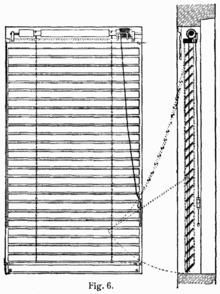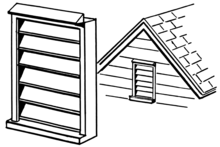louvre


A blind is an arrangement of fixed or movable slats for privacy and sun protection , but also for weather protection, which nevertheless allows the space behind it to be illuminated or ventilated. The slats of the blind can be made of (roll-formed) aluminum , wood , plastic , but also of glass or (stainless) steel. The slats can be fixed, rotatable or movable in another form. A retractable blind is called an external venetian blind or slat blind .
Jalousie [ ʒaluˈzi ] (feminine, French for “jealousy”; outdated also bar pull shutters ) initially referred to window grilles in France that were designed in such a way that they enabled a view outside and at the same time prevented a view inside. The name blind is explained by the replication of these grilles based on oriental models from harems , in which the householder jealously watched that the women's apartments were shielded from the outside world. Just like these oriental grilles, the first blind inserts for European shutters were initially not adjustable. It was not until April 14, 1812, that the carpenter Cochot registered his invention for a patent in Paris : a blind with adjustable and reversible boards (slats) that corresponds to the principle still used today. In terms of architectural history, the blind in the form of a lattice window ( transenna ) is probably older than the glass window.
In the warfare of the 18th and 19th centuries, blinds also meant minor attacks on the enemy in order to alarm them ("jealousy"), also known as "teasing".
species
External blinds
The external blind can be designed with fixed, rotating or moving slats (not to be confused with the roller shutter ). Like the inner blind, it serves to screen and light, but protects more effectively against heating up in summer, as the sun's rays are shaded before entering the room, the heat effect on the slats is cooled with outside air. External venetian blinds for heavy use have extra thick, flanged slats. Since external blinds are exposed to wind and weather, they are usually rail or cable guided. Motorized external blinds can be automatically retracted to protect against strong wind loads ( wind monitor ).
Since summer temperatures tend to rise, external shading measures for the cooling effect of indoor spaces are most effective and, compared to air conditioning systems based on refrigeration machines, there is no energy consumption that heats up the city, the City of Vienna is promoting the installation of external sun protection such as roller shutters in 2020-2025, Blinds and awnings for apartments in buildings that are at least 20 years old.
Interior blinds
Blinds for indoor use are usually designed to be movable as external venetian blinds. They can be mounted in different ways:
- in the glass strip (the strips with which the window glass is fixed in the sash frame)
- in the window niche (wall opening in which the window is installed)
- on the sash
- in front of the window niche (on the wall or the ceiling)
There are special clamp supports for PVC windows for installation on the window sash, so that no drilling is required in the window. In order to prevent the blind from protruding from the window when the window is tilted, blinds are installed with a so-called pendulum protection. The pendulum safety device consists of a wire or nylon thread that starts from the blind head and is threaded through each slat on the side. At the bottom, this is attached to the window with a bracket or other fastening. The pendulum lock can also be implemented with guide brackets attached to the side. The top of the head, in which the manual or motorized drive is housed, is usually made of folded sheet metal, the drop bar made of steel or plastic.
Built-in blinds
With composite windows, built-in blinds can be attached between the outer and inner sash or in the space between double glazing. Special built-in blinds (internal blinds) can also be installed directly in the space between the panes (SZR) of the insulating glass pane, where they are protected from contamination. Such blinds are operated by an electric motor, which is also integrated in the insulating glass, or by an external drive via a magnetic coupling.
Ventilation blinds
Ventilation blinds usually have fixed slats. They are often made of metal in building services and wood in furniture construction. Shutters can also be fitted with blinds. In the case of glazing that does not have to meet any requirements with regard to airtightness and thermal insulation, the glass itself can also be designed as a blind in the form of movable slats.
to form
Nowadays there is a suitable blind design for almost every window situation. In addition to triangular or trapezoidal designs, there are blinds in which only individual areas can be regulated as required, blinds that can be freely moved up or down, variants that guarantee a better view of the outside due to the louvre spacing when open, or blinds which enable better protection from the incidence of light by means of punched holes set backwards.
service
There are various mechanisms for operating the movable blind, external venetian blind or slat blinds :
- The blind is raised and lowered with a pull cord. The slats are turned either by turning a turning rod made of metal or plastic or with two additional cords.
- With an endless cord or an endless chain, which, unlike the pull cord, is led in a circle, the blind can be raised and lowered as well as turned.
- The blind can be raised and lowered as well as turned with a crank.
- With the help of an electric motor.
The operating logic with a one-dimensional drive is that a first movement first adjusts the angle of the slats. If the slat position comes to a stop, further movement of the drive (endless cord, crank or electric motor) is converted into raising or lowering of the blind. While roller shutters and simple roller blinds are rolled up on a winding axis, the slats of a blind gradually collect on the lowest, rigid and heavy-duty bottom slat when they are pulled up, in order to be lifted up with this tightly stacked.
External venetian blinds, slat blinds
The terms blind and external venetian blind are often used synonymously. In the industry, an arbitrary distinction is often made between blinds and external venetian blinds in order to emphasize certain product features, e.g. B. the windproof design. If the term is used correctly, the blind, consisting of fixed or movable slats, is the generic term for the retractable external venetian blind .
Common slat widths for commercial venetian blinds are 16 mm, 25 mm, 35 mm and 50 mm.
See also
Web links
Individual evidence
- ↑ Brockhaus Konversationslexikon 1908. Vol. 15, keyword bar pull store.
- ↑ Retrofit campaign: City of Vienna funds the installation of external sun protection with half the cost ots.at, City of Vienna, November 21, 2019, accessed November 30, 2019.






